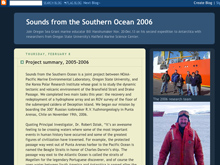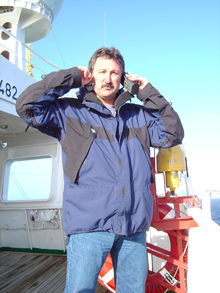
Using a blog, Bill Hanshumaker easily reported from the Antarctic on the progress of the mission, Sounds of the Southern Ocean 2006. Click image for larger view and image credit.
Blogging from Antarctica
When Oregon Sea Grant marine educator Bill Hanshumaker ![]() was preparing for his second trip to Antarctica with the NOAA-sponsored Sounds of the Southern Ocean research team, he knew he wanted to keep an on-line journal to describe the cruise and its discoveries. During the team's 2005 expedition, Hanshumaker had filed his reports by a circuitous email path to Webmaster Pat Kight, who formatted the entries as she got them — sometimes several days late — into custom-built Web pages describing the trip. It was a laborious process, fraught with delays caused by finicky satellite-to-Internet connections and competing demands on the Sea Grant Webmaster's time.
was preparing for his second trip to Antarctica with the NOAA-sponsored Sounds of the Southern Ocean research team, he knew he wanted to keep an on-line journal to describe the cruise and its discoveries. During the team's 2005 expedition, Hanshumaker had filed his reports by a circuitous email path to Webmaster Pat Kight, who formatted the entries as she got them — sometimes several days late — into custom-built Web pages describing the trip. It was a laborious process, fraught with delays caused by finicky satellite-to-Internet connections and competing demands on the Sea Grant Webmaster's time.
This time around, Kight suggested a more direct route: Blogging.
Blogs (originally known as "Web logs") are Web-based journals that make it easy for users to post their own updates to pre-formatted Web pages, with the opportunity for reader interaction via comments. While early blogs were mainly personal diaries, the medium has rapidly grown to encompass more than 60 million specialized blogs, covering every subject imaginable — from the serious to the whimsical. Science blogs are a growing category. Free or low-cost blogging services provide everything from page layout to archiving, making Web publishing available to those who don't have the time or interest to learn to build their own sites.
Once the Sounds of the Southern Ocean blog ![]() was set up, Hanshumaker quickly learned to compose and post articles, along with maps and photographs. In no time at all he as set the scene for the trip. Blogging seemed to be a relatively effortless way to communicate.
was set up, Hanshumaker quickly learned to compose and post articles, along with maps and photographs. In no time at all he as set the scene for the trip. Blogging seemed to be a relatively effortless way to communicate.
Of course, things became slightly more complicated once the team arrived in Antarctica.

During the 2005 mission, Bill Hanshumaker struggled to communicate by satellite phone. Blogging the 2006 mission was a major improvement. Click image for larger view and image credit.
"The challenge was the lack of satellite coverage from the Southern Ocean," Hanshumaker explains. "In 2005, none of the messages sent from aboard the Russian research vessel reached our Webmaster. This year, transmission was better, but the per-kilobyte transmission charge was still pretty high."
When Hanshumaker was unable to connect directly to the blog site, he emailed his expedition journal entries and low-resolution versions of his Antarctic photos to the Sea Grant Webmaster, who logged into the blog and posted them almost as soon as they arrived.
But Antarctica posed even more communication challenges. "The weather is so cold that rechargeable batteries for my cameras and laptop rapidly lose their charge," Hanshumaker recalls. "Last year, I would put the frozen battery in my armpit to warm it back to its charged state; this year, I brought two sets of batteries.
"We also tried to use satellite phones to communicate in real-time with radio stations back home in Oregon, but the satellites dipped below the horizon so quickly it was difficult to remain connected longer than five minutes."
Now in Oregon, Hanshumaker has been using the Antarctic blog as source material for public education and outreach efforts, including auditorium presentations, service club and professional conference meetings, and the development of an interactive kiosk exhibit at Oregon State University's Hatfield Marine Science Center, where he is based.
Meanwhile, Oregon Sea Grant is exploring the possibilities that blogging and other Web technology — from podcasts to wikis to on-line photo galleries — offer for supporting its marine research and outreach efforts.
"Small programs like ours don't have the technological or human resources to build everything from scratch," says Pat Kight, who is active in the nationwide network of NOAA/Sea Grant Web developers. "Where we can find appropriate technology from the marketplace at a reasonable cost and without compromising program values, it can help us in our mission to bring reliable, science-based information to the public at large."
Hanshumaker agrees. "The blog has tremendous potential both as a Web development and public education tool. Being able to hear critical comments from the public in real time helps in the formative evaluation process. Providing the public voice with a forum promotes their support for our efforts."
Related Links
Sounds from the Southern Ocean 2006 Blog
Sounds of the Southern Ocean 2006 Web Site
Sounds from the Southern Ocean 2005 Journal
Sign up for the Ocean Explorer E-mail Update List.




